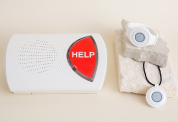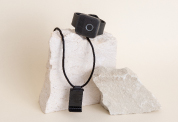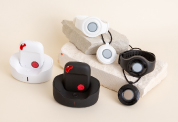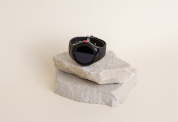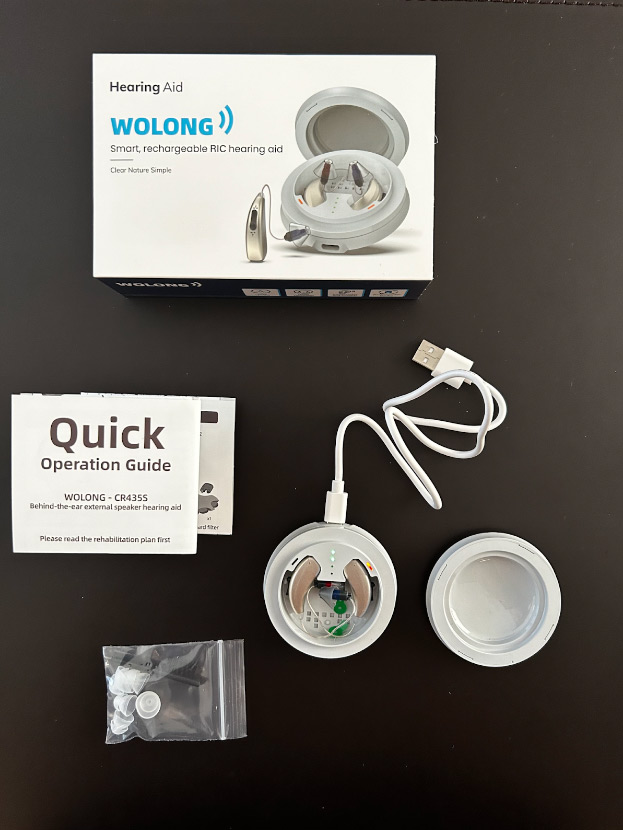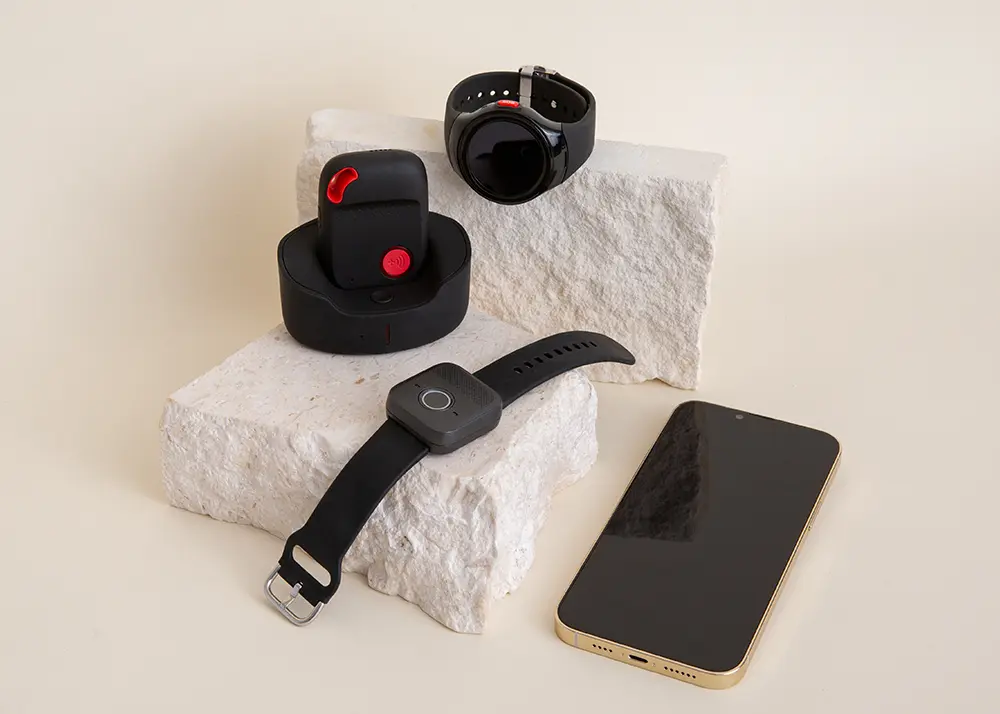The Best OTC Hearing Aids for Under $300
January 29, 2024
As we age, it is common to experience changes in your body. Body systems change, as do sensory organs like the eyes and ears. For many adults over the age of 60, some hearing loss is a normal part of sensory decline. For others, hearing loss is profound and can significantly impact daily routines, relationships, and quality of life.
The American Academy of Audiology reports that about 35% of adults over the age of 65 experience some type of hearing loss. Men are almost twice as likely as women to suffer from some level of hearing loss.
While hearing loss is certainly an inconvenience, its effects ripple into multiple facets of the person’s life. It can become more difficult to maintain friendships and relationships, causing some seniors with hearing loss to choose to isolate themselves, which can lead to cognitive decline and other health complications that come with loneliness. Hearing loss, when undiagnosed and untreated, can also lead to false diagnoses of dementia. In short, hearing loss can become a serious medical condition that can have significant consequences for seniors.
Hearing loss is generally a chronic condition that progresses over time. Unfortunately, there is no cure. However, medical devices such as hearing aids and cochlear implants can help improve hearing and increase quality of life.
Without insurance, a cochlear implant can cost anywhere from $30,000 to $50,000. Prescription hearing aids can cost anywhere from $4,000 to $8,000 per pair according to recent reporting from Forbes.
Fortunately, there are some ways to make hearing aids more affordable: an over-the-counter option. In contrast to the expensive prescription hearing aids,over-the-counter (OTC) hearing aids can cost anywhere from as little as $100 to as much as $1,800. This cost is much more affordable for the average older adult, especially since Medicare does not cover hearing aids or associated fees.
Affordability is the main reason people choose OTC hearing aids. In this guide, we help you choose some of the best options costing $300 or less.
MDHearing AIR 3
-
- Very good sound quality
- Programmable to your environment
- Affordable price
Key Takeaways
- Medicare doesn’t cover hearing aids or related fees.
- OTC hearing aids are a new, lower cost option for people with mild to moderate hearing loss.
- Amazon.com has a wide selection of OTC hearing aids and a 30-day return policy that lets you try a hearing aid.
- Budget OTC hearing aids generally have fewer features and aren’t customized to your specific hearing loss, but they can offer good sound quality.
Medicare’s Hearing Aid Shortfall
While it comes as a surprise to many people, Medicare does not cover hearing aids.
According to the Centers for Medicare & Medicaid Services (CMS), Medicare considers hearing aids to be elective devices, much like eyeglasses. As a result, they are not considered medically necessary items, leading to the exclusion of coverage.
Indeed, some experts consider this lack of coverage to be one of the biggest holes in Medicare, and it also is likely the reason why only 1 in 5 people with hearing loss get a hearing aid.
OTC Hearing Aids: A New Alternative
With Medicare offering little assistance in paying for hearing aids, other branches of the U.S. government have sought to help.
To increase public access to hearing aids, the Food and Drug Administration established a new category of over-the-counter (OTC) hearing ads. FDA approval came into effect on October 17, 2022, so this is a fairly new category of medical device.
As the name implies, OTC hearing aids can be purchased at your local pharmacy or store, or bought through online retailers. They don’t require a prescription and generally cost less than prescription hearing aids.
OTC Hearing Aids versus Prescription Hearing Aids
How do OTC hearing aids compare to prescription hearing aids?
Over-the-Counter (OTC) hearing aids differ from prescription hearing aids in several ways:
- Prescription Requirement: OTC hearing aids can be purchased without a prescription or audiology exam, while prescription hearing aids require an audiometric exam and prescription from a licensed hearing healthcare provider.
- Design and Usage: OTC hearing aids are designed for mild to moderate hearing loss in adults 18 years and older. In contrast, prescription hearing aids can treat all levels of hearing loss, from mild to profound, in both children and adults.
- Customization and Assessment: Prescription hearing aids are tailored based on a thorough examination by an audiologist, including an ear exam and auditory tests. The audiologist will tune prescription hearing aids to compensate for your specific hearing loss, boosting the frequencies where you need the most help. OTC hearing aids, on the other hand, may rely on online tests or none at all, which might not provide a comprehensive diagnosis.
- Features: Prescription hearing aids come with advanced features, such as wireless connectivity with smart devices, noise-filtering, health monitoring, and activity tracking. Though some high-end OTC hearing aids such as Jabra and Lexie have one or more of these features, it’s important to check what you’re getting with your device. Generally speaking, the more expensive your OTC hearing aid, the more features you can expect. But read the product details before you buy.
- Fit & Comfort: You want your hearing aids to fit correctly in your ear, both for comfort and to help you hear better. Prescription hearing aids are fitted by a professional, ensuring comfort and proper fit, whereas OTC hearing aids are self-fitted, and so their fit might not be as precise.
- Ongoing Care: Prescription hearing aids include ongoing monitoring and care from a hearing healthcare provider, whereas OTC hearing aids may lack this crucial monitoring.
- Cost and Services: OTC hearing aids are less expensive than prescription hearing aids. However, they may not include services like professional calibration, fittings, adjustments, and regular hearing health assessments, which are part of the package with prescription hearing aids.
Typical Price of a Prescription Hearing Aid
Prescription hearing aids can cost anywhere from $4,000 to $8,000 per pair. The average price is around $2,500.
Typical price of an OTC hearing aid
OTC hearing aids come in a wide range of prices, from as low as $100 to $1,800 or more. That means some high-end OTC hearing aids can cost more than prescription hearing aids.
Generally speaking, the higher priced hearing aids have more features. In particular, some higher priced aids help you tune the device to your hearing range or offer online consultations with an audiologist.
But there are good value options that cost less than $300. Below are our top picks.
What Is Mild to Moderate Hearing Loss?
OTC hearing aids are designed to help mild to moderate hearing loss, but what exactly does that mean? WebMD offers a good guide.
If you have mild hearing loss, you typically cannot hear:
- People whispering
- Refrigerators humming
- Water babbling in a brook or stream
If you have moderate hearing loss, you typically cannot hear:
- People working in a quiet office
- Rain falling
- Coffee brewing in a coffee machine
If you have moderate-to-severe hearing loss, you cannot hear:
- People talking at normal volume
- People laughing
- The dishwasher running
If you have severe hearing loss, you cannot hear:
- Doorbells or telephones ringing
- Vacuum cleaners running
- Traffic noise
Your physician can recommend a type of over-the-counter hearing aid that suits your hearing loss, if you ask. They might also point you to discounted audiologist exams that can give you further direction before you head to the pharmacy to purchase your first pair.
Where To Buy OTC Hearing Aids
Buying Through Amazon.com – All of the hearing aids we review in this article are available through Amazon.com. Amazon offers a wide range of choices, though that abundance of choice can itself be confusing. We’ve done our best to filter the options and focus on some of the most attractive offerings.
A key reason for buying from Amazon is its return policy. Nearly all of the hearing aids sold through Amazon are returnable, and that’s true even if you’ve worn them. That allows you to order and try a hearing aid to see how it works for you.
Make sure you check each product’s return policy before purchasing. You can find the return policy just below the Buy Now button on Amazon.
Buying Through CVS or Walgreens – You can also buy OTC hearing aids through CVS Health, Walgreens or other pharmacies, either at your local store or order online through their websites. You’ll find fewer choices through your pharmacy, with only a few options in stores.
Return policies from pharmacies may not be as generous as you’ll find through Amazon.
For example, the CVS Health website’s return policy states that “Most new, unopened items purchased from CVS Pharmacy or CVS.com can be returned to any CVS Pharmacy store within 60 days of purchase for exchange or refund.” That means you may not be able to return your hearing aid once you’ve opened the box and tried it.
How We Tested
We performed over 42 hours of research and testing on leading OTC hearing aids. We first reviewed the range devices available through Amazon.com, comparing price, features and online reviews.
We evaluated more than 20 devices, from which we chose three devices costing below $300 for detailed hands-on testing:
- MDHearing AIR 3
- iBstone K19
- BSLLTER
Our Evaluation Criteria
In evaluating OTC hearing aids, we scored each according to a number of criteria:
Sound Quality – By far our most important evaluation criteria was sound quality. We performed hands-on testing of our top hearing aid picks, which is to say, we performed in-ear tests to evaluate the quality of sound provided by each device (It should be noted that our testers have normal hearing).
Style – Hearing aids may be either behind-the-ear or in-the-ear. Behind-the-ear devices have a receiver that sits in the ear canal, while another component of the device loops over your ear. In-the-ear devices use only one component that sits in the ear canal. In-the-ear devices are less visible, which appeals to many people. Behind-the-ear devices typically include a volume control that you can adjust with your fingers, something that in-the-ear devices lack. We looked at the pros and cons of each style.
Customizable – We checked if each hearing aid could be tailored to your individual hearing needs. While some of the more expensive OTC hearing aids have this feature (see Jabra and Lexie), none of the budget OTC hearing aids we tested allow customization.
Programmable – Hearing can be more challenging in noisy environments, so it’s good if your hearing aid can correct for that. Some OTC hearing aids allow you to adjust for the environment by selecting specific hearing programs for a quiet home, social outing or noisy restaurant.
Hearing Test – Some OTC hearing aid companies offer a free online hearing test.
Battery Life – As a rule, you’ll need to charge your hearing aids every night. But if you miss a night, it’s good to have a hearing aid with longer battery life or an aid that charges quickly.
Bluetooth – Some OTC hearing aids feature bluetooth connectivity. Bluetooth allows you to adjust the hearing aids volume through a paired app, which can be easier than fumbling with an on-device volume control. Bluetooth can also be used for hands-free calling.
Here’s how our top choices compare on price and features.
| MDHearing AIR 3 | iBstone K19 | BSLLTER | |
|---|---|---|---|
|
Sound Quality
|
Very Good | Excellent | Good |
|
Style
|
Behind-the-Ear | In-the-Ear | Behind-the-Ear |
|
Customizable
|
– | – | – |
|
Programmable
|
|
– | – |
|
Hearing Test
|
|
– | – |
|
Battery Life
|
12-16 hours | 24 hours | 18 hours |
|
Bluetooth
|
– | – | – |
|
Price
|
$297 | $149 | $218.99 |
Our Top Picks
Of the 20+ hearing aids we evaluated, we selected three to perform detailed hands-on tests. Here’s what we found.
MDHearing AIR 3
The MDHearing AIR 3 was our choice for the Best Budget OTC Hearing Aid. At a price of $297, it is brushing up against our $300 limit. But the AIR 3’s sound quality and superior features make it our top choice.
The AIR 3 is a behind-the-ear device. Each aid has a small earpiece that sits in your ear canal, with the earpiece linked to a shell that sits behind the ear. The shell includes the hearing aid’s microphones and volume control. The shell’s microphones pick up sound and transmit it to the “comfort tip” earpiece, where you can hear the amplified sound.
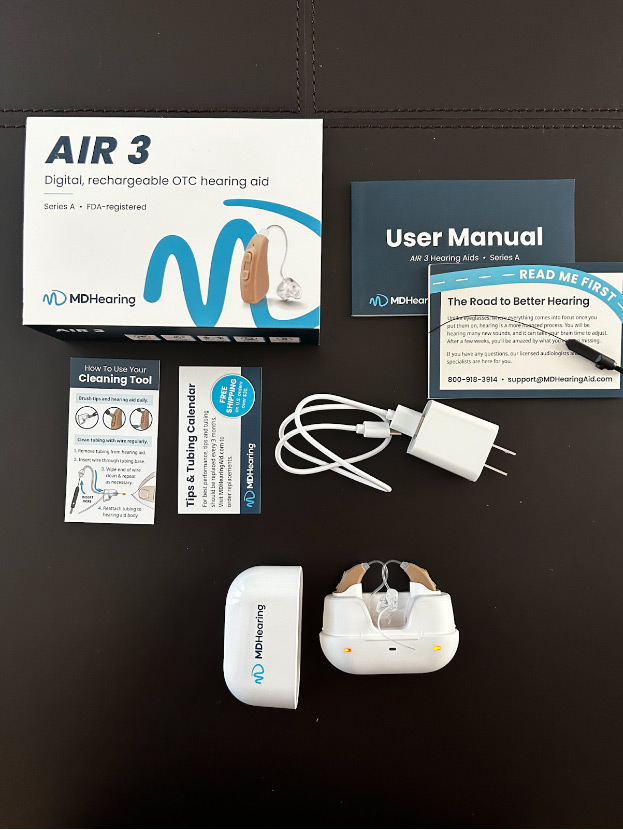
Unlike the other OTC hearing aids we tested, the AIR 3’s earpiece comes with a single comport tip. In our case the earpiece fits comfortably in our ears, but it would be nice to have tips of different sizes for a better fit. The earpiece fit can be a factor in your quality of hearing.
There are two hearing aids in the package, with the small color code to indicate the left (blue) and right (red) hearing aids. Each behind-the-ear shell includes a volume control that you can toggle up or down.
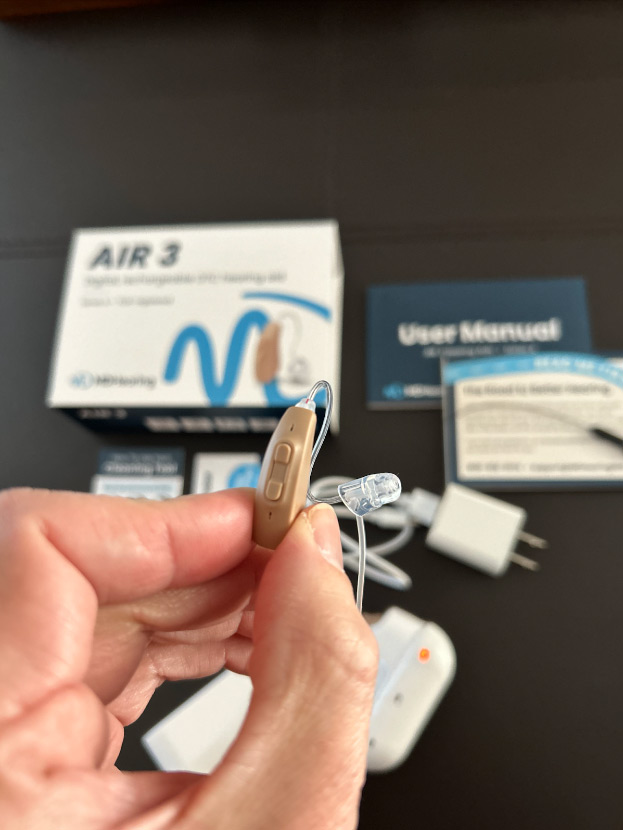
The AIR 3 doesn’t tailor its amplification to your specific hearing needs. However, it is the only budget OTC hearing aid that includes different audio programs for different environments. You can choose one of four options:
- Quiet – Used for watching TV or time with family at home
- Social – Time with friends or small groups
- Noisy – Large crowds, traffic or high octave music
- Restaurant – Any loud environment where you need to reduce background noise.
This option is the main reason we chose the AIR 3 as the Best Budget OTC Hearing Aid.
That said, we found the program selection awkward. To select your program, you use the same up/down controls you use to adjust the volume. To change the program, you need to press and hold the volume control for 2 seconds until you hear a beep. The number of beeps tells you which program you’ve selected.
In testing, we fumbled a bit with the behind-the-ear toggle switch, both for setting the volume and especially for selecting the audio program. After a few tries, we were able to figure it out, but it takes some practice.
The AIR 3 doesn’t feature bluetooth. If that’s a key feature for you, you have the option to buy the MDHearing VOLT for $397. The VOLT allows you to control its volume, select your hearing program and check your battery level through the MDHearing smartphone app.
The AIR 3 comes with a charging case. Set year hearing aids in the case to charge; they fit easily, with no worries about good charging contact.
The charging case itself can charge the aids even when the case is not plugged into a power outlet. The case can charge your hearing aids up to 3 times before the case itself needs to recharge. That means you can recharge the case while you’re wearing the hearing aids. It also means you can take the case with you and charge the hearing aids anywhere as needed. We liked this feature.
The AIR 3 doesn’t come charged, so you’ll need to charge it in its case for 3-4 hours before first use. When fully charged, the hearing aids have a battery life of 12-16 hours. If your battery is fully spent, the hearing aids need 5 hours to fully charge and the charging case can take up to 4 hours to charge.
We tested the AIR 3 in a quiet environment using its default audio program. Overall we were impressed with the sound quality. We could clearly hear subtle sounds that we didn’t notice in daily life, like the pages of the user manual rustling as we flipped through them.
We also tested the aids while playing an electronic jazz tune through a nearby speaker, then comparing the sounds with and without the aids. We found the sound amplification was slightly biased toward higher frequencies, but the overall sound was very good. The amplification was subtle and not blaring.
MDHearing offers a free online hearing test through its website, which is a nice feature. The test is available to anyone. You don’t need to buy a device to take it.
Buy the MDHearing AIR 3 on Amazon for $297 >>
iBstone K19 Hearing Amplifier
The iBstone Hearing Amplifier doesn’t present itself as a hearing aid, but rather as a hearing amplifier. We think that’s accurate, since it boosts all frequencies, not just the ones where you have hearing loss.
While the K19 wasn’t our top pick as a budget OTC hearing aid, it was a close second for several reasons.
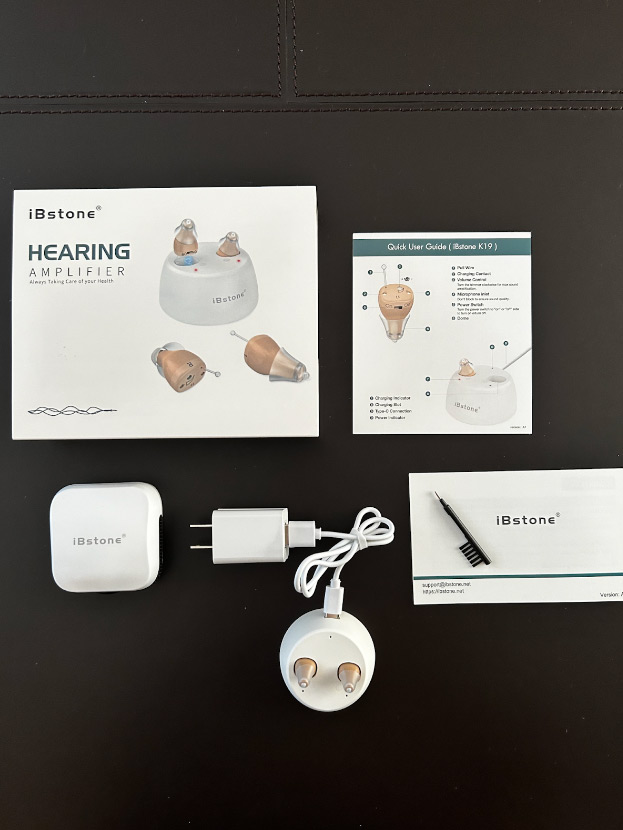
First, the iBstone K19 is an in-the-ear hearing aid, with no behind-the-ear component. That means the K19 is almost invisible when wearing, which is an important feature for many people.
At Bay Alarm Medical, we provide medical alert systems for seniors and to their families or caregivers. We know that many seniors are reluctant to use any sort of medical device as they age. So having a medical device that’s discrete and unnoticeable can determine whether the device gets used at all.
If discretion is important to you, then the iBstone K19 may be the best choice for you.
Secondly, among the hearing aids in our live test, the iBstone gave the best sound quality, amplifying all frequencies well, with a just slightly tinny sound for the higher frequencies. In particular, when we tested using an electronic jazz tune, the K19 hearing aid gave a rich, broad spectrum amplification.
However, like all other in-the-ear hearing aids, the K19 hearing has only a pinhole volume control that cannot be adjusted while you wear the device. It requires a special screwdriver to adjust the volume control.
To make matters more complicated, the package includes the special screwdriver you need and a separate ear wax removal tool, so it’s confusing which one adjusts the volume. For the record, you adjust the volume using the tool with the cleaning brush at the other end.
While we understand the need to have tiny controls on a very small hearing aid, it’s easy to imagine this becoming a problem in daily use. If you need to adjust volume away from home, you need to take the screwdriver with you. If you take the screwdriver with you, you increase the chance of losing it.
The K19 does not feature bluetooth, so there is no way to adjust the hearing aids volume using an app.
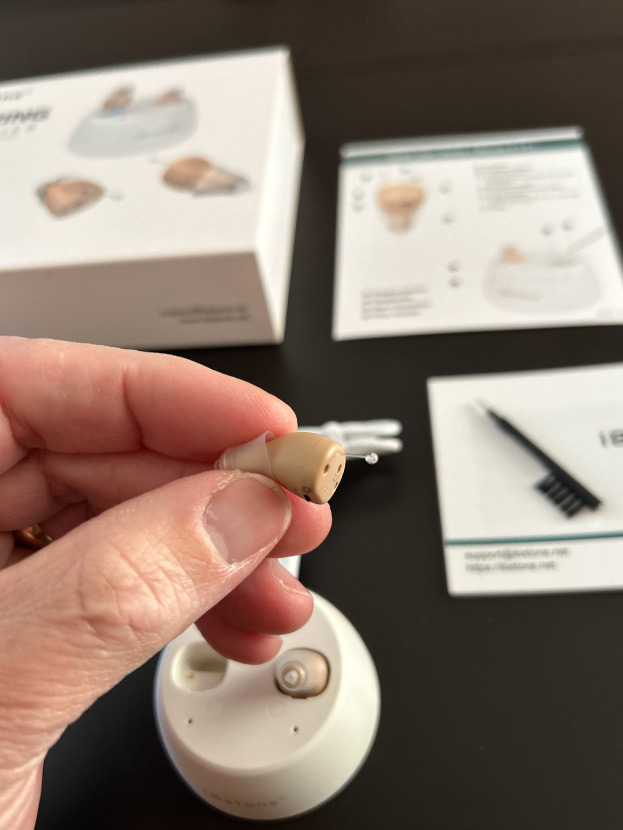
We should note that small volume controls are common to all in-the-ear hearing aids, and it can be a challenge to find a discrete in-the-ear hearing aid that also supports bluetooth volume adjustment.
Since the K19 hearing aids are small, they feature a pull wire to help you take them out of your ear.
The aids come with several sets of clear plastic ear domes in different sizes to help the aid sit snugly in your ear, letting you pick the one that best fits your ear. This helps both the comfort of the hearing aid and its sound quality.
Each hearing aid has features small, color-coded letter telling you whether it goes in the right or left ear. Because the hearing aids are so small, it was hard for us to see the letters. We can see this being a challenge for seniors with poor eyesight.
The K19 comes with a charging case. The hearing aids fit easily into the case and snap into place via magnets, so you can be sure they have good contact for charging. You will need 3-6 hours to fully charge the K19 aids. Once charged, they have an excellent battery life of up to 20 hours.
Buy the iBstone K19 hearing aid for $149 on Amazon >>
BSLLTER Hearing Aids
Among the budget OTC hearing aids we reviewed, the BSLLTER Hearing Aid scored the lowest in our tests.
Though the product is sold under the BSLLTER brand, the product itself arrives as the Wolong Hearing Aid. We aren’t put off by this, since it’s not unusual for medical device vendors to use third-party hardware. But it is unusual for the vendor not to relabel the packaging, and we can see where this might cause confusion.
We found the BSLLTER’s sound quality to be decidedly tinny and strongly biased toward the high end of the frequency range. While hearing loss tends to be more prominent at the high end of the audio spectrum, the overall sound quality at other frequencies was not as good as the other devices we tested.
The BSLLTER is a behind-the-ear hearing aid, with both an in-the-ear receiver and a shell that sits behind the ear. The shell includes microphones and a volume control, similar to the AIR 3 noted above. We found BSLLTER’s volume control to be well-designed and easy to operate.
We also liked that the package came with multiple hearing domes for the in-ear receiver, letting us pick one that gave the best fit in our ear.
The aids themselves could emit a high-pitched chirping noise when removed from their charging case or when fitted into our ears. In fairness, all hearing aids can have this behavior if their volume control is set too high or if the device is not fully charged. However, the effect was stronger with the BSLLTER than with any other aid we tested. We also experienced it even when the hearing aids were fully charged.
Like other hearing aids, BSLLTER comes with a charging case. The case itself uses a USB-A cable to charge, but the package does not include a USB charging plug! You need to provide your own plug, which might be a challenge for a senior who isn’t tech savvy or anyone unclear on the difference between USB-A or USB-C chargers.
The BSLLTER does not support bluetooth connectivity.
At a price of $249.99, the BSLLTER is more expensive than the iBstone K19, which is more discrete and offers better sound quality. It’s only $50 less than the MDHearing AIR 3, but the AIR 3 offers more features and better sound quality.
Buy the BSLLTER for $249.99 on Amazon >>
The Bottom Line
The $297 MDHearing AIR 3 is a great choice for a budget OTC hearing aid. If you can afford a little more, the $397 MDHearing VOLT has all the features of the AIR 3, but adds bluetooth support and an app that lets you more easily manage your device.
If discretion is key for you, then the iBstone K19 in-the-ear hearing aid is another good choice. Its earpiece-only design makes it nearly invisible. While we found its tiny volume controls to be a challenge, it gave the best sound quality among the OTC hearing aids we tested.
Whatever OTC hearing aid you choose, make sure you pick one with a good return policy. That way you can try the hearing aid and make sure it’s right for you.
